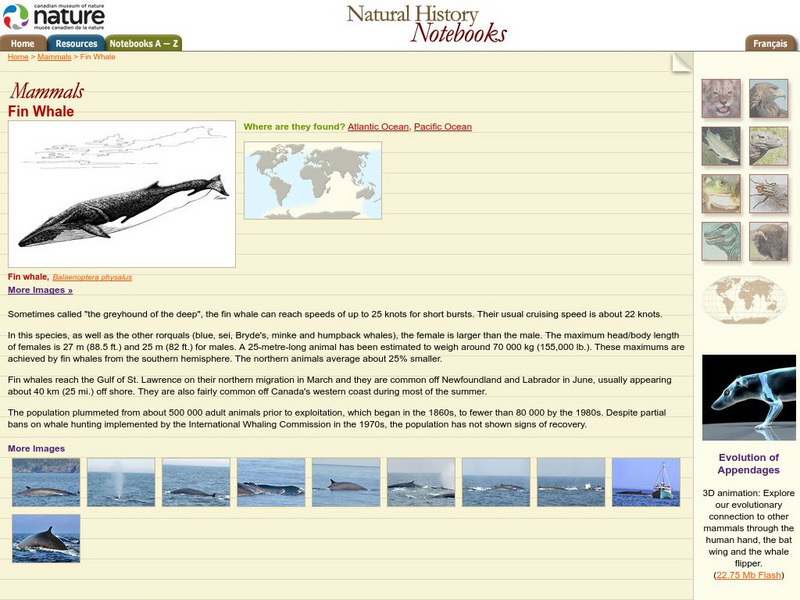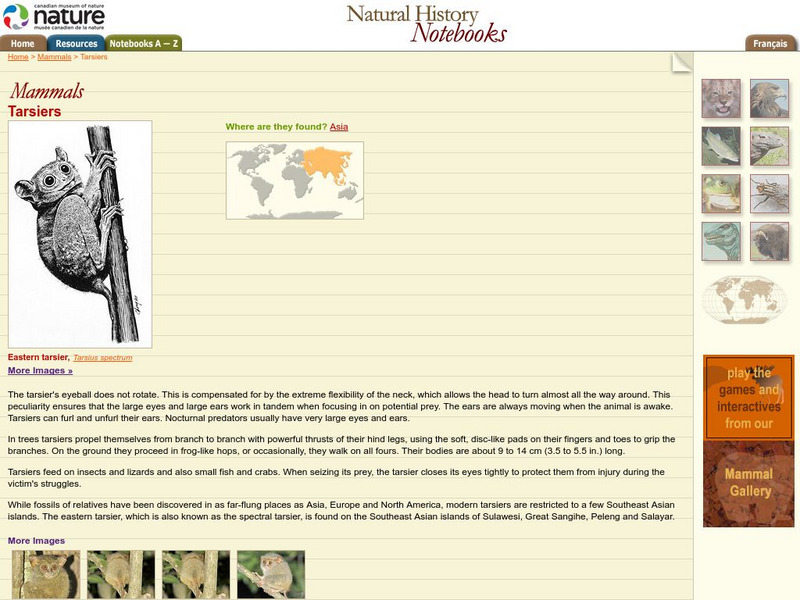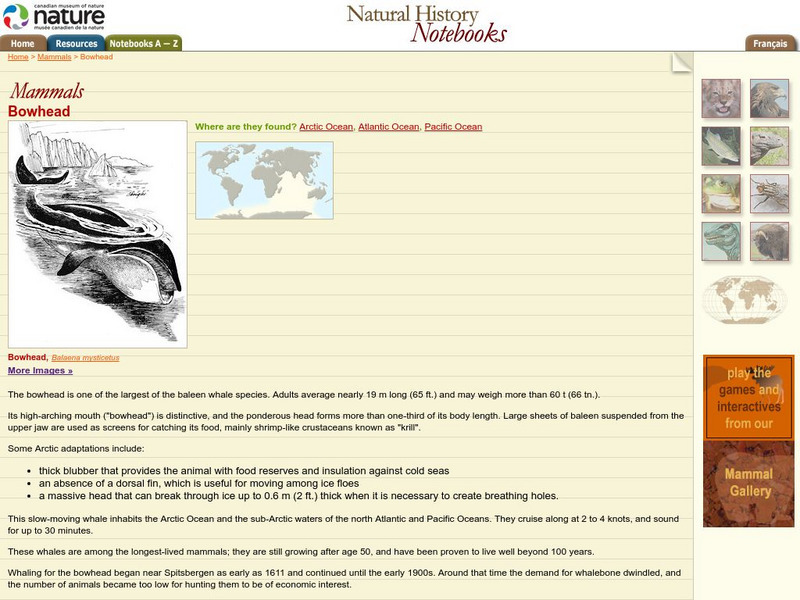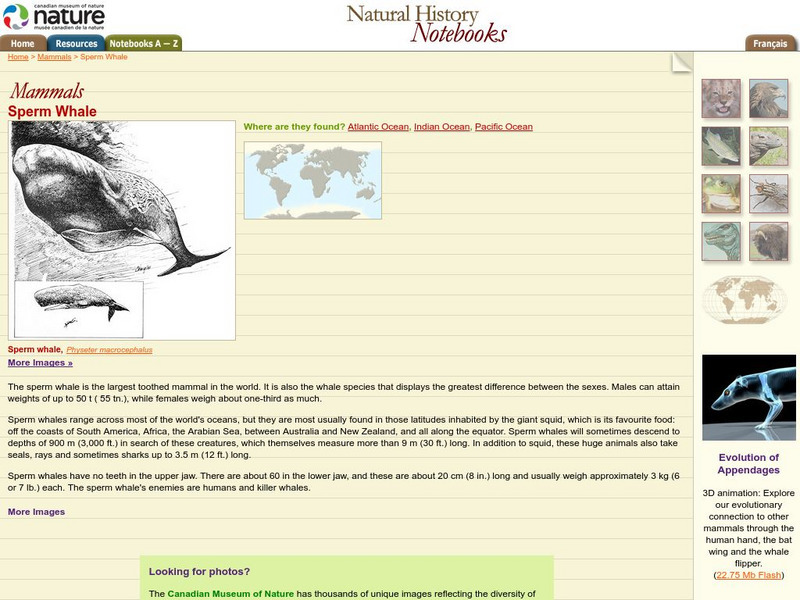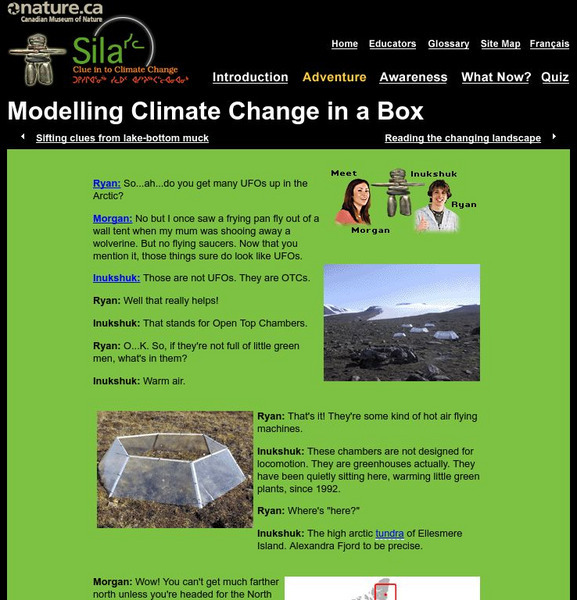Canadian Museum of Nature
Canadian Museum of Nature: Bighorn Sheep
Bighorn sheep can be found in the Canadian Rockies and in some parts of the United States and Mexico. Read some fascinating facts about these unique creatures. Pictures can also be found here.
Canadian Museum of Nature
Canadian Museum of Nature: Northern Flying Squirrel
The northern flying squirrel can be found widely in Canadian forests. Its diet, physical features and mating habits are described here.
Canadian Museum of Nature
Canadian Museum of Nature: Fin Whale
Gives some basic information about the fin whale, which can be seen in eastern Canada's waters during its summer migration. There is concern about the fin whale population, as it has not regained its robustness since bans on whale...
Canadian Museum of Nature
Canadian Museum of Nature: Eastern Chipmunk
Eastern chipmunks can be found in North American forests in eastern Canada. They are popular for their friendly interactions with humans. Details about their habits and diet are given here.
Canadian Museum of Nature
Canadian Museum of Nature: Tarsiers
The tarsier is a fascinating animal. Its eyes and neck coordinate to allow it to see well, and its ears can curl and uncurl. The tarsier is found in South East Asia. Details about its physical features and diet are given here.
Canadian Museum of Nature
Canadian Museum of Nature: North American Elk
The North American elk is commonly called the wapiti. It is almost as large as a moose. Basic facts about the North American elk are given here.
Canadian Museum of Nature
Canadian Museum of Nature: Northern Elephant Seal
Information about the northern elephant seal is found here, along with some photos.
Canadian Museum of Nature
Canadian Museum of Nature: Bowhead Whale
The bowhead whale is on the endangered list as efforts continue to be made to bolster its population. Details about this Arctic animal can be found here.
Canadian Museum of Nature
Canadian Museum of Nature: Indricotherium
The Canadian Museum profiles the largest land mammal known to humans-the Indricotherium.
Canadian Museum of Nature
Canadian Museum of Nature: Hyracotherium
This site briefly unravels the ancestry of the modern horse from the Hyracotherium.
Canadian Museum of Nature
Canadian Museum of Nature: Blue Whale
The blue whale is believed to be the largest animal that has ever existed on Earth, even larger than dinosaurs were. These gentle creatures are at risk and only about 10,000 remain today. Learn some interesting facts about them here.
Canadian Museum of Nature
Canadian Museum of Nature: Zebras
Did you know that there are three species of zebra in Africa? Described are its location and characteristics. Included are ten excellent photographs.
Canadian Museum of Nature
Canadian Museum of Nature: Yak
Did you know that yaks have been domesticated for at least 2000 years? General information describes its characteristics and location.
Canadian Museum of Nature
Canadian Museum of Nature: Wolverine
Described are the appearance,characteristics, food, and range of this member of the weasel family. Eight photographs provide excellent close up views.
Canadian Museum of Nature
Canadian Museum of Nature: White Rhinoceros
The white rhinoceros is not white, but light grey. This is just one of the interesting facts about this large and powerful animal. Included are eight images with close ups that highlight the rhinoceros' features.
Canadian Museum of Nature
Canadian Museum of Nature: Sperm Whale
Briefly described are the appearance, characteristics and location of the Sperm Whale, the largest toothed mammal in the world.
Canadian Museum of Nature
Canadian Museum of Nature: Spotted Hyena
The Canadian Museum of Nature provides a concise introduction to the Spotted Hyena. Learn some basic facts about this African savannah predator. Pictures of the Spotted Hyena are also provided.
Canadian Museum of Nature
Canadian Museum of Nature: Grey Whale
The Canadian Museum of Nature provides a concise introduction to the Grey Whale. Learn some basic facts about this large baleen whale. Pictures of the Grey Whale are also provided.
Canadian Museum of Nature
Canadian Museum of Nature: Wildebeests
The Canadian Museum of Nature provides a concise introduction to wildebeests. Learn some basic facts about this large member of the antelope family. A great set of pictures of wildebeests is also provided.
Canadian Museum of Nature
Canadian Museum of Nature: Modelling Climate Change in a Box
Students model climate change in an experiment. Provides directions and models to accomplish this experiment on global warming.
Canadian Museum of Nature
Canadian Museum of Nature: Reading the Changing Landscape
What will happen if climate change continues to occur? Studies show how it will affect the people on the fringes of society first, like the Inuits.
Canadian Museum of Nature
Canadian Museum of Nature: Let's Do Science Programs
Site provides three lesson plans about global warming including one that discusses scenarios for future generations.
Canadian Museum of Nature
Canadian Museum of Nature: Bees
Bees are found all over the world and are vital for controlling other insect populations. Some basic facts about bees can be read here, and there are pictures as well.




